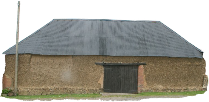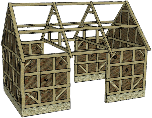Barns are usually classified by regional type (Kentish, Cotswold etc.) by material (stone/timber) or by structure (cruck frame, aisled etc.) Unfortunately, few of them fit into a neat classification. For example, Titchfield Abbey Barn which was originally built as a timber-framed aisled barn, subsequently had one long wall and a gable end replaced by flint and brick, so that now from one side it is a stone, aisled barn, and from the other side it is a timber-clad, aisled barn with some brick walling.
Similarly, cruck-framed barns may have any type of wall fabric as the crucks support the roof independently of the walls. However the crucks are quite difficult to replace, so when they failed, they were often replaced by some other type of truss sitting directly on a stone wall, eg. Newhall Farm Barn.
Although somewhere like Kent has a long, unbroken stylistic tradition, in other areas styles and bulding techniques appear and disappear. For instance in the Berkshire, South Oxfordshire, Buckinghamshire area, “cranked or curved under-principals” appeared in the middle of the eighteenth century and persisted for about a hundred years. Not only does this structure appear in stone, aisled and post and truss barns, but there is not even any agreement as to its correct terminology.
In order to overcome these problems, I have chosen a number of main and sub-categories and used a “best–fit” approach to allocating the barns. Obviously some of the barns fit into several categories. As well as the conventional idea of a “Barn Conversion” I have included several barns that were converted from other buildings into barns, usually monastic buildings after the Dissolution of the Monasteries. I have used different categories in my introduction, as my perception and understanding is constantly evolving. You may well disagree with some of my choices. I hope this will encourage you to research more fully for yourself.












